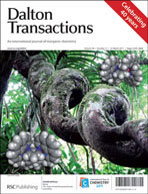The protonation/demetallation reaction, in CD3COOD, of phosphine monometallated triacetato-bridged dirhodium(II) complexes of general formulae [Rh2(μ-OOCCH3)3{(RC5CH3)P(RC6H4)2}2] has been studied from a kinetico-mechanistic perspective. The process has been monitored via the disappearance of the nuclear magnetic resonance signals of the protons present in the non-metallated ortho positions of the phosphine ligand and taking advantage of the relatively fast back metallation process that follows the acidolysis reaction, the sequence behaving as an overall equilibrium reaction. The process has a high associative character with important entropy demands, increasing both for the larger and the more electron withdrawing phosphine ligands. For the complexes with electron withdrawing CF3 substituents on the cyclometallated phenyl ring, this demand is compensated by very low activation enthalpies. The data agree with an intimate mechanism that corresponds to the reverse of the electrophilic C–H bond activation, which has already been studied for this type of system, and requires the presence of a protonated acetato ligand in the axial position, close to the metallated Rh–Caromatic bond. The involvement of external solvent molecules, interacting viahydrogen bonds with the system, is also evident for systems which include CF3 groups with the correct geometric arrangement.

You have access to this article
 Please wait while we load your content...
Something went wrong. Try again?
Please wait while we load your content...
Something went wrong. Try again?


 Please wait while we load your content...
Please wait while we load your content...